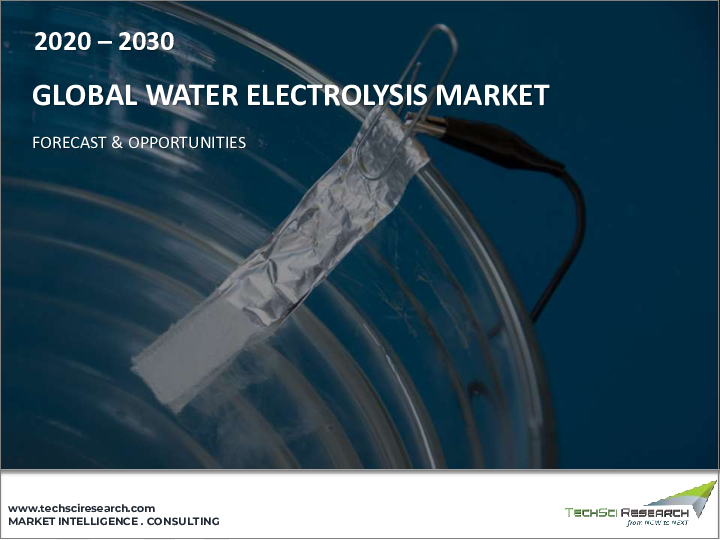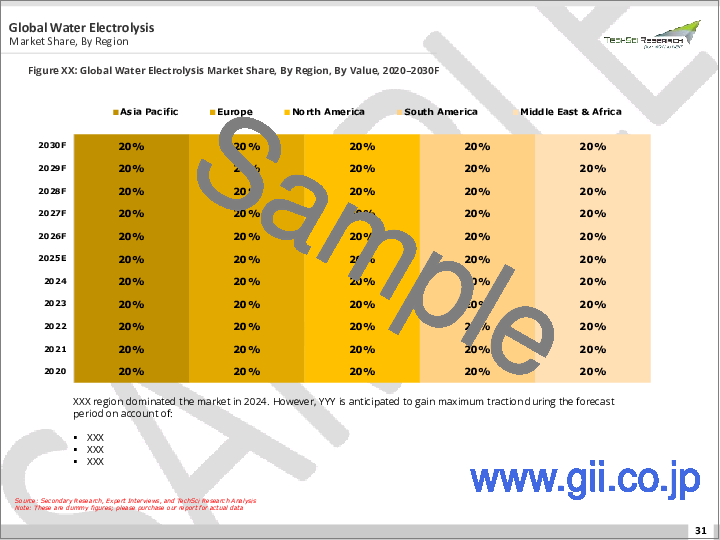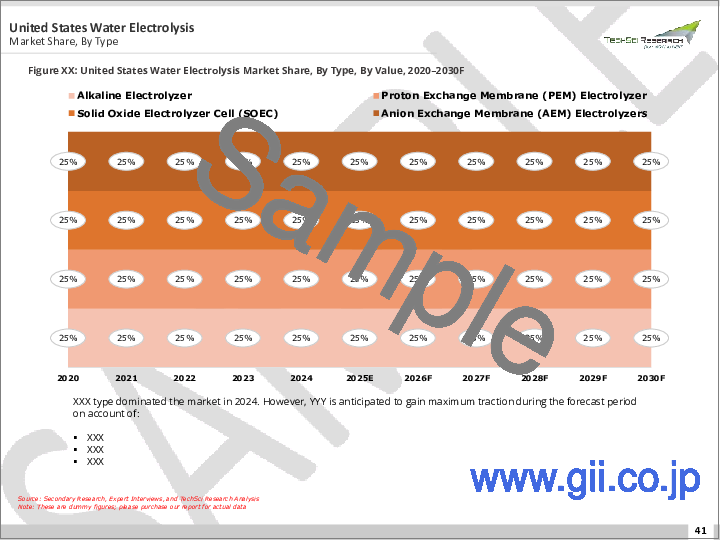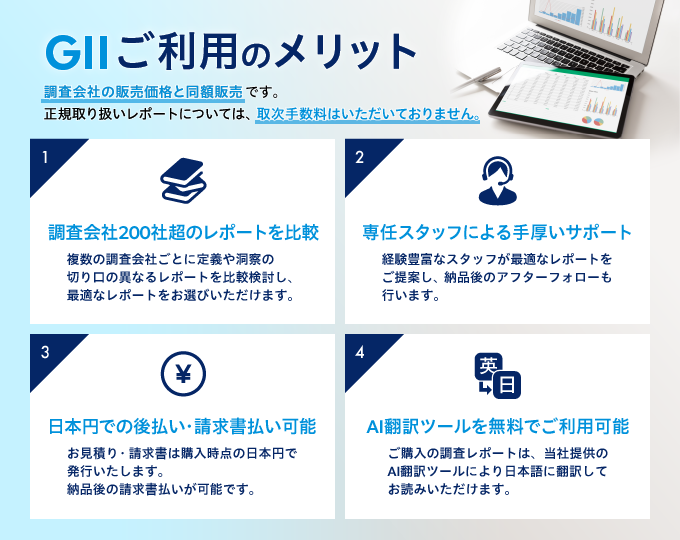|
|
市場調査レポート
商品コード
1477379
水電解市場- 世界の産業規模、シェア、動向、機会、予測、タイプ別、用途別、地域別、競合別、2019年~2029年Water Electrolysis Market - Global Industry Size, Share, Trends, Opportunity, and Forecast, Segmented By Type, By Application, By Region and Competition, 2019-2029F |
||||||
カスタマイズ可能
|
|||||||
| 水電解市場- 世界の産業規模、シェア、動向、機会、予測、タイプ別、用途別、地域別、競合別、2019年~2029年 |
|
出版日: 2024年05月06日
発行: TechSci Research
ページ情報: 英文 185 Pages
納期: 2~3営業日
|
全表示
- 概要
- 目次
世界の水電解市場は、2023年に44億2,000万米ドルと評価され、2029年までのCAGRは4.31%で、予測期間に力強い成長を予測されています。
風力発電や太陽光発電のような再生可能エネルギーの利用が増加していることが、世界の水電解市場を推進している主な要因です。電解は、特に再生可能エネルギーの普及率が高い地域において、余剰再生可能エネルギーの変換と貯蔵に重要な役割を果たしています。再生可能エネルギー源の余剰電力を電気分解による水素製造に活用することで、余剰エネルギーを貯蔵し、発電、輸送、工業プロセスなど様々な分野で活用することができ、それによって送電網の安定性と柔軟性を高めることができます。
| 市場概要 | |
|---|---|
| 予測期間 | 2025-2029 |
| 2023年の市場規模 | 44億2,000万米ドル |
| 2029年の市場規模 | 56億3,000万米ドル |
| CAGR 2024-2029 | 4.31% |
| 急成長セグメント | アルカリ電解槽 |
| 最大市場 | 欧州 |
脱炭素化と低炭素エネルギーシステムへの移行への注目の高まりが、水電解によって生成されるグリーン水素の需要を促進しています。再生可能な電力を使って製造されるグリーン水素は、水蒸気メタン改質のような従来の方法に代わるカーボンニュートラルな選択肢を提供します。政府や産業界が世界的に野心的な二酸化炭素削減目標を設定し、気候変動に取り組んでいることから、グリーン水素の需要は拡大すると予想され、世界の水電解市場の拡大を牽引しています。
電解槽技術の進歩と再生可能エネルギーのコスト低下が、水電解システムの商業的実現性を高めています。メーカーは、電解技術の効率性、信頼性、拡張性を高めるための研究開発に投資しており、従来の化石燃料ベースのプロセスに対する競争力を高めています。太陽光発電や風力発電のような再生可能エネルギー源のコスト低下は、電解による水素製造コスト全体を引き下げ、市場成長をさらに刺激しています。
再生可能エネルギーと水素技術の促進を目的とした政府の支援政策とインセンティブも、世界の水電解市場の成長に寄与しています。世界各国の政府は、電解システムやグリーン水素インフラの開発・展開を促進するため、補助金、税制優遇措置、規制枠組みなど様々な施策を実施しています。これらの政策は、電解プロジェクトへの投資を促進し、水電解技術の採用を促進するために、政府、産業界、研究機関の協力を促しています。
主な市場促進要因
電力産業の成長
技術進歩の急増
主な市場課題
再生可能エネルギーの利用可能性
主な市場動向
グリーン水素への注目の高まり
セグメント別洞察
タイプ別洞察
用途別洞察
地域別洞察
目次
第1章 概要
第2章 調査手法
第3章 エグゼクティブサマリー
第4章 世界の水電解市場へのCOVID-19の影響
第5章 世界の水電解市場の展望
- 市場規模と予測
- 金額別
- 市場シェアと予測
- タイプ別(アルカリ電解槽、プロトン交換膜(PEM)電解槽、固体酸化物電解槽セル(SOEC)、陰イオン交換膜(AEM)電解槽)
- 用途別(精製産業、電力・エネルギー貯蔵、アンモニア製造、メタノール製造、輸送・モビリティ産業、その他)
- 地域別
- 企業別(2023年)
- 市場マップ
第6章 アジア太平洋の水電解市場の展望
- 市場規模・予測
- 金額別
- 市場シェアと予測
- タイプ別
- 用途別
- 国別
- アジア太平洋地域国別分析
- 中国
- インド
- オーストラリア
- 日本
- 韓国
第7章 欧州の水電解市場の展望
- 市場規模と予測
- 金額別
- 市場シェアと予測
- タイプ別
- 用途別
- 国別
- 欧州国別分析
- フランス
- ドイツ
- スペイン
- イタリア
- 英国
第8章 北米水電解市場の展望
- 市場規模・予測
- 金額別
- 市場シェアと予測
- タイプ別
- 用途別
- 国別
- 北米国別分析
- 米国
- メキシコ
- カナダ
第9章 南米の水電解市場の展望
- 市場規模と予測
- 金額別
- 市場シェアと予測
- タイプ別
- 用途別
- 国別
- 南米:国別分析
- ブラジル
- アルゼンチン
- コロンビア
第10章 中東・アフリカの水電解市場の展望
- 市場規模・予測
- 金額別
- 市場シェアと予測
- タイプ別
- 用途別
- 国別
- MEA:国別分析
- 南アフリカ
- サウジアラビア
- アラブ首長国連邦
第11章 市場力学
- 促進要因
- 課題
第12章 市場動向と発展
- 最近の動向
- 製品上市
- 合併と買収
第13章 世界の水電解市場SWOT分析
第14章 ポーターのファイブフォース分析
- 業界内の競合
- 新規参入の可能性
- サプライヤーの力
- 顧客の力
- 代替品の脅威
第15章 PESTLE分析
第16章 競合情勢
- Asahi Kasei Corporation
- Nel ASA
- thyssenkrupp AG
- Cummins Inc.
- Toshiba Energy Systems & Solutions Corporation
- Teledyne Technologies Incorporated
- Suzhou Green Hydrogen Energy Co., Ltd.
- ITM Power PLC
- Clean Power Hydrogen plc
- Plug Power Inc.
第17章 戦略的提言
第18章 調査会社・免責事項
Global Water Electrolysis Market was valued at USD 4.42 billion in 2023 and is anticipated to project robust growth in the forecast period with a CAGR of 4.31% through 2029. The increasing utilization of renewable energy sources like wind and solar power is a key factor propelling the global water electrolysis market. Electrolysis plays a vital role in converting and storing surplus renewable energy, especially in regions with high renewable energy penetration. By leveraging excess electricity from renewable sources for hydrogen production through electrolysis, surplus energy can be stored and utilized across various sectors such as power generation, transportation, and industrial processes, thereby enhancing grid stability and flexibility.
| Market Overview | |
|---|---|
| Forecast Period | 2025-2029 |
| Market Size 2023 | USD 4.42 Billion |
| Market Size 2029 | USD 5.63 Billion |
| CAGR 2024-2029 | 4.31% |
| Fastest Growing Segment | Alkaline Electrolyzer |
| Largest Market | Europe |
The growing focus on decarbonization and the transition to low-carbon energy systems is fueling demand for green hydrogen generated via water electrolysis. Green hydrogen, produced using renewable electricity, offers a carbon-neutral alternative to conventional methods like steam methane reforming. With governments and industries globally setting ambitious carbon reduction goals and addressing climate change, the demand for green hydrogen is anticipated to escalate, driving the expansion of the global water electrolysis market.
Advancements in electrolyzer technologies and the decreasing costs of renewable energy are bolstering the commercial feasibility of water electrolysis systems. Manufacturers are investing in research and development to enhance the efficiency, reliability, and scalability of electrolysis technologies, making them more competitive against traditional fossil fuel-based processes. The declining costs of renewable energy sources such as solar and wind power are lowering the overall hydrogen production costs through electrolysis, further stimulating market growth.
Supportive government policies and incentives aimed at promoting renewable energy and hydrogen technologies are also contributing to the growth of the global water electrolysis market. Governments worldwide are implementing various measures like subsidies, tax incentives, and regulatory frameworks to facilitate the development and deployment of electrolysis systems and green hydrogen infrastructure. These policies are fostering investments in electrolysis projects and encouraging collaboration among governments, industries, and research institutions to expedite the adoption of water electrolysis technology.
Key Market Drivers
Growth in Power Industry
The rapid expansion of renewable energy sources like wind and solar power stands as a primary catalyst propelling the global water electrolysis market forward. With nations worldwide committing to ambitious targets for reducing greenhouse gas emissions and addressing climate change, the deployment of renewable energy technologies has surged. Wind and solar power, in particular, have experienced exponential growth, fueled by declining costs, technological advancements, and supportive governmental policies.
Water electrolysis plays a pivotal role in facilitating the integration of renewable energy into the power grid. Electrolyzers can harness surplus electricity generated by wind and solar farms during periods of low demand to produce hydrogen via electrolysis. This green hydrogen can then be stored and utilized as a clean energy carrier for diverse applications, spanning power generation, transportation, and industrial processes. As the proportion of renewable energy in the energy mix continues to rise, the demand for water electrolysis systems to yield green hydrogen is poised to skyrocket, propelling market expansion.
The burgeoning power sector is fueling investments in electrolysis projects and infrastructure development. Power firms are increasingly investing in electrolysis facilities and hydrogen production plants to leverage surplus renewable energy and facilitate grid stabilization. Partnerships between power entities, electrolyzer manufacturers, and research institutions are fostering innovation in electrolysis technologies, driving the creation of more efficient and economically viable electrolysis systems.
The transition toward decarbonizing the power sector is generating fresh avenues for water electrolysis. As power entities aim to shrink their carbon footprint and adhere to stringent environmental regulations, hydrogen generated through electrolysis emerges as a clean and sustainable substitute for traditional fossil fuel-based power generation. The escalating adoption of hydrogen as a power generation fuel, coupled with advancements in electrolysis technologies, is steering the expansion of the global water electrolysis market.
Surge in Technological Advancements
Technological progress has spurred the emergence of advanced electrolysis technologies like proton exchange membrane (PEM) electrolysis and solid oxide electrolysis cells (SOECs). These innovations boast heightened energy efficiency, swifter response times, and enhanced durability compared to conventional alkaline electrolysis methods, rendering them more appealing for commercial use. PEM electrolysis is gaining momentum due to its capability to operate at elevated current densities and lower temperatures, resulting in diminished energy consumption and augmented rates of hydrogen production.
Innovations in materials science and engineering have yielded more resilient and enduring electrolysis components, encompassing catalysts, membranes, and electrodes. These breakthroughs have elongated the lifespan of electrolysis systems, reducing maintenance expenses and downtime while enhancing overall system dependability. Enhanced durability is indispensable for commercial electrolysis applications, where uninterrupted operation and minimal upkeep are imperative.
Technological advancements have facilitated the integration of water electrolysis systems with renewable energy sources like solar and wind power. These systems can now dynamically adapt their operations to match the fluctuating output of renewable energy sources, optimizing energy utilization and bolstering grid stability. The fusion of water electrolysis with renewable energy sources enables the generation of "green hydrogen," characterized by minimal carbon footprint, which can aid in decarbonizing diverse sectors such as transportation, industry, and power generation.
Key Market Challenges
Availability of Renewable Energy
One of the primary hurdles related to utilizing renewable energy for water electrolysis lies in the intermittent nature of renewable energy sources such as solar and wind power. Unlike conventional power sources like coal or natural gas, which offer a consistent and dependable electricity supply, renewable energy sources are subject to external factors like weather conditions and time of day. This intermittency can result in fluctuations in power generation, posing challenges in maintaining steady electrolysis operations and hydrogen production.
Another challenge stems from the disparity between the availability of renewable energy and the demand for hydrogen. In numerous regions, renewable energy generation may surpass demand at certain times, leading to energy curtailment or wastage. There may be instances where renewable energy supply falls short of meeting demand, thereby limiting the availability of clean electricity for water electrolysis. Achieving a balance between renewable energy supply and hydrogen demand to optimize the utilization of electrolysis systems presents a logistical and technical obstacle for stakeholders across the hydrogen value chain.
The integration of renewable energy sources into existing electrical grids and infrastructure introduces further complexities for the water electrolysis market. Grid integration necessitates the implementation of smart grid technologies, energy storage solutions, and grid stabilization mechanisms to manage fluctuations in renewable energy output and ensure grid reliability. The availability of infrastructure for transporting renewable energy from generation sites to electrolysis facilities may be constrained, particularly in remote or underserved areas.
Key Market Trends
Growing Focus on Green Hydrogen
The electrolyzer technology market is experiencing rapid evolution, characterized by efforts to boost efficiency, trim costs, and enhance scalability. Innovative designs like proton exchange membrane (PEM) and alkaline electrolyzers are gaining traction, particularly for their capacity to operate effectively alongside renewable energy sources.
The increasing emphasis on green hydrogen as a sustainable energy carrier is poised to drive substantial growth in the global water electrolysis market in the foreseeable future. Critical factors such as technological breakthroughs, supportive governmental policies, market incentives, and collaborative ventures are set to fuel market expansion, accelerating the shift towards a hydrogen-centric economy.
The amalgamation of electrolysis with renewable energy sources, coupled with advancements in hydrogen storage and distribution infrastructure, will bolster the feasibility and competitiveness of green hydrogen as a clean energy alternative. As the world endeavors to meet ambitious climate targets and transition to a low-carbon trajectory, the significance of green hydrogen and water electrolysis in facilitating decarbonization and fostering energy sustainability will become increasingly indispensable.
Segmental Insights
Type Insights
Based on the category of type, the alkaline electrolyzer emerged as the fastest growing segment in the global market for water electrolysis in 2023. For numerous years, alkaline electrolyzers have been actively utilized in commercial settings, boasting a longstanding presence as a tried-and-tested technology. Renowned for their reliability, durability, and scalability, they stand out as a favored option across diverse applications such as industrial hydrogen generation, energy storage solutions, and power-to-gas initiatives.
Operating at elevated efficiencies, alkaline electrolyzers excel in converting electrical energy into hydrogen while minimizing energy losses. This heightened efficiency is instrumental in optimizing the utilization of renewable energy sources and facilitating cost-efficient hydrogen production, rendering alkaline electrolyzers particularly appealing for the generation of green hydrogen.
Application Insights
The power and energy storage segment is projected to experience rapid growth during the forecast period. Water electrolysis is instrumental in the integration of renewable energy by transforming surplus electricity from sources like wind and solar power into hydrogen through electrolysis. This process, referred to as Power-to-Gas (P2G) or Power-to-Hydrogen (P2H), facilitates the storage of renewable energy as hydrogen for later use in power generation, transportation fuel, or industrial applications. By leveraging water electrolysis, power and energy storage applications enable efficient utilization and storage of renewable energy, addressing challenges related to intermittency and variability in renewable power generation.
In power and energy storage applications, water electrolysis aids in grid balancing and peak shaving by absorbing excess electricity during periods of low demand or high renewable energy generation, and releasing it during periods of high demand or low renewable energy availability. Integrating electrolyzers into the electricity grid infrastructure allows for grid-scale energy storage, supporting grid stability and mitigating issues such as grid congestion, voltage fluctuations, and frequency regulation.
Regional Insights
Europe emerged as the dominant player in the Global Water Electrolysis Market in 2023, holding the largest market share in terms of value. European nations have taken proactive steps to promote renewable energy and advance decarbonization agendas through favorable government policies and incentives. Key initiatives like the European Green Deal, national hydrogen strategies, and carbon neutrality targets have spurred investments in clean hydrogen technologies, particularly water electrolysis.
The integration of renewable energy sources such as wind and solar power into Europe's energy portfolio has been notably successful. This has resulted in ample availability of renewable energy resources for utilization in water electrolysis, rendering it an appealing option for hydrogen generation.
Europe benefits from a robust research and innovation landscape focused on clean energy technologies, including electrolysis. Research institutions, universities, and technology firms in Europe lead the charge in developing cutting-edge electrolysis technologies, materials, and manufacturing processes. Their efforts drive innovation and enhance global competitiveness in the market.
Key Market Players
Asahi Kasei Corporation
Nel ASA
thyssenkrupp AG
Cummins Inc.
Toshiba Energy Systems & Solutions Corporation
Teledyne Technologies Incorporated
Suzhou Green Hydrogen Energy Co., Ltd.
ITM Power PLC
Clean Power Hydrogen plc
Plug Power Inc.
Report Scope:
In this report, the Global Water Electrolysis Market has been segmented into the following categories, in addition to the industry trends which have also been detailed below:
Water Electrolysis Market, By Type:
-
Alkaline Electrolyzer
Proton Exchange Membrane (PEM) Electrolyzer
Solid Oxide Electrolyzer Cell (SOEC)
Anion Exchange Membrane (AEM) Electrolyzers
Water Electrolysis Market, By Application:
-
Refining Industry
Power and Energy Storage
Ammonia Production
Methanol Production
Transportation/Mobility Industry
Others
Water Electrolysis Market, By Region:
-
North America
United States
Canada
Mexico
-
Europe
France
United Kingdom
Italy
Germany
Spain
-
Asia Pacific
China
India
Japan
Australia
South Korea
-
South America
Brazil
Argentina
Colombia
-
Middle East & Africa
South Africa
Saudi Arabia
UAE
Competitive Landscape
Company Profiles: Detailed analysis of the major companies present in the Global Water Electrolysis Market.
Available Customizations:
Global Water Electrolysis Market report with the given market data, Tech Sci Research offers customizations according to a company's specific needs. The following customization options are available for the report:
Company Information
Detailed analysis and profiling of additional market players (up to five).
Table of Contents
1. Product Overview
- 1.1. Market Definition
- 1.2. Scope of the Market
- 1.2.1. Markets Covered
- 1.2.2. Years Considered for Study
- 1.2.3. Key Market Segmentations
2. Research Methodology
- 2.1. Objective of the Study
- 2.2. Baseline Methodology
- 2.3. Key Industry Partners
- 2.4. Major Association and Secondary Sources
- 2.5. Forecasting Methodology
- 2.6. Data Triangulation & Validation
- 2.7. Assumptions and Limitations
3. Executive Summary
- 3.1. Overview of the Market
- 3.2. Overview of Key Market Segmentations
- 3.3. Overview of Key Market Players
- 3.4. Overview of Key Regions/Countries
- 3.5. Overview of Market Drivers, Challenges, Trends
4. Impact of COVID-19 on Global Water Electrolysis Market
5. Global Water Electrolysis Market Outlook
- 5.1. Market Size & Forecast
- 5.1.1. By Value
- 5.2. Market Share & Forecast
- 5.2.1. By Type (Alkaline Electrolyzer, Proton Exchange Membrane (PEM) Electrolyzer, Solid Oxide Electrolyzer Cell (SOEC), Anion Exchange Membrane (AEM) Electrolyzers)
- 5.2.2. By Application (Refining Industry, Power and Energy Storage, Ammonia Production, Methanol Production, Transportation/Mobility Industry, Others)
- 5.2.3. By Region
- 5.2.4. By Company (2023)
- 5.3. Market Map
6. Asia Pacific Water Electrolysis Market Outlook
- 6.1. Market Size & Forecast
- 6.1.1. By Value
- 6.2. Market Share & Forecast
- 6.2.1. By Type
- 6.2.2. By Application
- 6.2.3. By Country
- 6.3. Asia Pacific: Country Analysis
- 6.3.1. China Water Electrolysis Market Outlook
- 6.3.1.1. Market Size & Forecast
- 6.3.1.1.1. By Value
- 6.3.1.2. Market Share & Forecast
- 6.3.1.2.1. By Type
- 6.3.1.2.2. By Application
- 6.3.1.1. Market Size & Forecast
- 6.3.2. India Water Electrolysis Market Outlook
- 6.3.2.1. Market Size & Forecast
- 6.3.2.1.1. By Value
- 6.3.2.2. Market Share & Forecast
- 6.3.2.2.1. By Type
- 6.3.2.2.2. By Application
- 6.3.2.1. Market Size & Forecast
- 6.3.3. Australia Water Electrolysis Market Outlook
- 6.3.3.1. Market Size & Forecast
- 6.3.3.1.1. By Value
- 6.3.3.2. Market Share & Forecast
- 6.3.3.2.1. By Type
- 6.3.3.2.2. By Application
- 6.3.3.1. Market Size & Forecast
- 6.3.4. Japan Water Electrolysis Market Outlook
- 6.3.4.1. Market Size & Forecast
- 6.3.4.1.1. By Value
- 6.3.4.2. Market Share & Forecast
- 6.3.4.2.1. By Type
- 6.3.4.2.2. By Application
- 6.3.4.1. Market Size & Forecast
- 6.3.5. South Korea Water Electrolysis Market Outlook
- 6.3.5.1. Market Size & Forecast
- 6.3.5.1.1. By Value
- 6.3.5.2. Market Share & Forecast
- 6.3.5.2.1. By Type
- 6.3.5.2.2. By Application
- 6.3.5.1. Market Size & Forecast
- 6.3.1. China Water Electrolysis Market Outlook
7. Europe Water Electrolysis Market Outlook
- 7.1. Market Size & Forecast
- 7.1.1. By Value
- 7.2. Market Share & Forecast
- 7.2.1. By Type
- 7.2.2. By Application
- 7.2.3. By Country
- 7.3. Europe: Country Analysis
- 7.3.1. France Water Electrolysis Market Outlook
- 7.3.1.1. Market Size & Forecast
- 7.3.1.1.1. By Value
- 7.3.1.2. Market Share & Forecast
- 7.3.1.2.1. By Type
- 7.3.1.2.2. By Application
- 7.3.1.1. Market Size & Forecast
- 7.3.2. Germany Water Electrolysis Market Outlook
- 7.3.2.1. Market Size & Forecast
- 7.3.2.1.1. By Value
- 7.3.2.2. Market Share & Forecast
- 7.3.2.2.1. By Type
- 7.3.2.2.2. By Application
- 7.3.2.1. Market Size & Forecast
- 7.3.3. Spain Water Electrolysis Market Outlook
- 7.3.3.1. Market Size & Forecast
- 7.3.3.1.1. By Value
- 7.3.3.2. Market Share & Forecast
- 7.3.3.2.1. By Type
- 7.3.3.2.2. By Application
- 7.3.3.1. Market Size & Forecast
- 7.3.4. Italy Water Electrolysis Market Outlook
- 7.3.4.1. Market Size & Forecast
- 7.3.4.1.1. By Value
- 7.3.4.2. Market Share & Forecast
- 7.3.4.2.1. By Type
- 7.3.4.2.2. By Application
- 7.3.4.1. Market Size & Forecast
- 7.3.5. United Kingdom Water Electrolysis Market Outlook
- 7.3.5.1. Market Size & Forecast
- 7.3.5.1.1. By Value
- 7.3.5.2. Market Share & Forecast
- 7.3.5.2.1. By Type
- 7.3.5.2.2. By Application
- 7.3.5.1. Market Size & Forecast
- 7.3.1. France Water Electrolysis Market Outlook
8. North America Water Electrolysis Market Outlook
- 8.1. Market Size & Forecast
- 8.1.1. By Value
- 8.2. Market Share & Forecast
- 8.2.1. By Type
- 8.2.2. By Application
- 8.2.3. By Country
- 8.3. North America: Country Analysis
- 8.3.1. United States Water Electrolysis Market Outlook
- 8.3.1.1. Market Size & Forecast
- 8.3.1.1.1. By Value
- 8.3.1.2. Market Share & Forecast
- 8.3.1.2.1. By Type
- 8.3.1.2.2. By Application
- 8.3.1.1. Market Size & Forecast
- 8.3.2. Mexico Water Electrolysis Market Outlook
- 8.3.2.1. Market Size & Forecast
- 8.3.2.1.1. By Value
- 8.3.2.2. Market Share & Forecast
- 8.3.2.2.1. By Type
- 8.3.2.2.2. By Application
- 8.3.2.1. Market Size & Forecast
- 8.3.3. Canada Water Electrolysis Market Outlook
- 8.3.3.1. Market Size & Forecast
- 8.3.3.1.1. By Value
- 8.3.3.2. Market Share & Forecast
- 8.3.3.2.1. By Type
- 8.3.3.2.2. By Application
- 8.3.3.1. Market Size & Forecast
- 8.3.1. United States Water Electrolysis Market Outlook
9. South America Water Electrolysis Market Outlook
- 9.1. Market Size & Forecast
- 9.1.1. By Value
- 9.2. Market Share & Forecast
- 9.2.1. By Type
- 9.2.2. By Application
- 9.2.3. By Country
- 9.3. South America: Country Analysis
- 9.3.1. Brazil Water Electrolysis Market Outlook
- 9.3.1.1. Market Size & Forecast
- 9.3.1.1.1. By Value
- 9.3.1.2. Market Share & Forecast
- 9.3.1.2.1. By Type
- 9.3.1.2.2. By Application
- 9.3.1.1. Market Size & Forecast
- 9.3.2. Argentina Water Electrolysis Market Outlook
- 9.3.2.1. Market Size & Forecast
- 9.3.2.1.1. By Value
- 9.3.2.2. Market Share & Forecast
- 9.3.2.2.1. By Type
- 9.3.2.2.2. By Application
- 9.3.2.1. Market Size & Forecast
- 9.3.3. Colombia Water Electrolysis Market Outlook
- 9.3.3.1. Market Size & Forecast
- 9.3.3.1.1. By Value
- 9.3.3.2. Market Share & Forecast
- 9.3.3.2.1. By Type
- 9.3.3.2.2. By Application
- 9.3.3.1. Market Size & Forecast
- 9.3.1. Brazil Water Electrolysis Market Outlook
10. Middle East and Africa Water Electrolysis Market Outlook
- 10.1. Market Size & Forecast
- 10.1.1. By Value
- 10.2. Market Share & Forecast
- 10.2.1. By Type
- 10.2.2. By Application
- 10.2.3. By Country
- 10.3. MEA: Country Analysis
- 10.3.1. South Africa Water Electrolysis Market Outlook
- 10.3.1.1. Market Size & Forecast
- 10.3.1.1.1. By Value
- 10.3.1.2. Market Share & Forecast
- 10.3.1.2.1. By Type
- 10.3.1.2.2. By Application
- 10.3.1.1. Market Size & Forecast
- 10.3.2. Saudi Arabia Water Electrolysis Market Outlook
- 10.3.2.1. Market Size & Forecast
- 10.3.2.1.1. By Value
- 10.3.2.2. Market Share & Forecast
- 10.3.2.2.1. By Type
- 10.3.2.2.2. By Application
- 10.3.2.1. Market Size & Forecast
- 10.3.3. UAE Water Electrolysis Market Outlook
- 10.3.3.1. Market Size & Forecast
- 10.3.3.1.1. By Value
- 10.3.3.2. Market Share & Forecast
- 10.3.3.2.1. By Type
- 10.3.3.2.2. By Application
- 10.3.3.1. Market Size & Forecast
- 10.3.1. South Africa Water Electrolysis Market Outlook
11. Market Dynamics
- 11.1. Drivers
- 11.2. Challenges
12. Market Trends & Developments
- 12.1. Recent Developments
- 12.2. Product Launches
- 12.3. Mergers & Acquisitions
13. Global Water Electrolysis Market: SWOT Analysis
14. Porter's Five Forces Analysis
- 14.1. Competition in the Industry
- 14.2. Potential of New Entrants
- 14.3. Power of Suppliers
- 14.4. Power of Customers
- 14.5. Threat of Substitute Product
15. PESTLE Analysis
16. Competitive Landscape
- 16.1. Asahi Kasei Corporation
- 16.1.1. Business Overview
- 16.1.2. Company Snapshot
- 16.1.3. Products & Services
- 16.1.4. Financials (As Reported)
- 16.1.5. Recent Developments
- 16.2. Nel ASA
- 16.3. thyssenkrupp AG
- 16.4. Cummins Inc.
- 16.5. Toshiba Energy Systems & Solutions Corporation
- 16.6. Teledyne Technologies Incorporated
- 16.7. Suzhou Green Hydrogen Energy Co., Ltd.
- 16.8. ITM Power PLC
- 16.9. Clean Power Hydrogen plc
- 16.10. Plug Power Inc.




